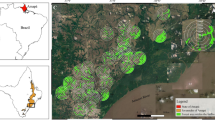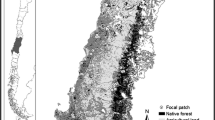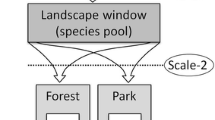Abstract
To conserve and manage the bat population in an agricultural landscape, we investigated the relative importance of environmental factors on their occurrence and abundance in riparian zones at site and landscape scales. From May to October 2003, four bat species (Myotis daubentonii, M. frater, Plecotus auritus, and Eptesicus nilssonii) were mist-netted at 26 sampling sites in five streams in the Tokachi plain in central Hokkaido, northern Japan. The environmental factors of the two scales were measured at each sampling site. To clarify the most suitable landscape scale for bats, we also compared three spatial extents (250, 500, and 750 m) at each site. Generalized linear mixed models revealed that the occurrence and/or abundance of all four species, except for M. frater, was positively correlated with the percent cover of broadleaved deciduous forest and the height of bank-side tree canopy. Additionally, according to variation partitioning, although the value of the pure effect varied among species and measurement types, the site scale had a relatively larger pure effect than the landscape scale in many cases. However, in three of the five combined models, the proportion of confounding effect was much larger than that of the pure effect at the respective scales. Our study demonstrated that streams adjacent to a well-developed broadleaved deciduous forest are important for night habitats of many bat species in an agricultural landscape. Although focusing on the site scale may be important for bat conservation, we strongly stress the necessity for conservation and management plans at multiple scales.


Similar content being viewed by others
References
Akasaka M, Takamura N, Mitsuhashi H, Kadono Y (2009a) Effects of land use on aquatic macrophyte diversity and water quality of ponds. Freshw Biol. doi: 10.1111/j.1365-2427.2009.02334.x (in press)
Akasaka T, Nakano D, Nakamura F (2009b) Influence of prey variables, food supply, and river restoration on the foraging activity of Daubenton’s bat (Myotis daubentonii) in the Shibetsu River, a large lowland river in Japan. Biol Conserv 142:1302–1310. doi:10.1016/j.biocon.2009.01.028
Anderson ME, Racey PA (1991) Feeding-behavior of captive Brown long-eared bats, Plecotus-Auritus. Anim Behav 42:489–493
Belanger L, Grenier M (2002) Agriculture intensification and forest fragmentation in the St. Lawrence valley, Quebec, Canada. Landscape Ecol 17:495–507. doi:10.1023/A:1021443929548
Boonman AM, Boonman M, Bretschneider F, van de Grind WA (1998) Prey detection in trawling insectivorous bats: duckweed affects hunting behaviour in Daubenton’s bat, Myotis daubentonii. Behav Ecol Sociobiol 44:99–107. doi:10.1007/s002650050521
Borcard D, Legendre P, Drapeau P (1992) Partialling out the spatial component of ecological variation. Ecology 73:1045–1055
Bowman J, Forbes G, Dilworth T (2001) Landscape context and small-mammal abundance in a managed forest. For Ecol Manag 140:249–255. doi:10.1016/S0378-1127(00)00315-7
Brookes A (1988) Channelized rivers. Wiley, Chichester
Burnham PB, Anderson DR (1998) Model selection and multimodel inference: a practical information-theoretic approach. Springer, Berlin
Ciechanowski M (2002) Community structure and activity of bats (Chiroptera) over different water bodies. Mamm Biol 67:276–285. doi:10.1078/1616-5047-00042
Crawley M (2002) Statistical computing: an introduction to data analysis using S-plus. Wiley, London
Dejong J (1994) Habitat use, home-range and activity pattern of the northern bat, Eptesicus-Nilssoni, in a Hemiboreal Coniferous Forest. Mammalia 58:535–548
Dobson A (1999) An introduction to generalized linear models. Chapman, London
Encarnacao JA, Kierdorf U, Holweg D, Jasnoch U, Wolters V (2005) Sex-related differences in roost-site selection by Daubenton’s bats Myotis daubentonii during the nursery period. Mammal Rev 35:285–294. doi:10.1111/j.1365-2907.2005.00066.x
Endo K (1967) Hunting flies of Myotis frater kaguyae (in Japanese). J Mammal Soc 3:64–67
Entwistle AC, Racey PA, Speakman JR (1996) Habitat exploitation by a gleaning bat, Plecotus auritus. Philos T Roy Soc B 351:921–931
Flavin DA, Biggane SS, Shiel CB, Smiddy P, Fairley JS (2001) Analysis of the diet of Daubenton’s bat Myotis daubentonii in Ireland. Acta Theriol 46:43–52
Fletcher RJ, Hutto RL (2008) Partitioning the multi-scale effects of human activity on the occurrence of riparian forest birds. Landscape Ecol 23:727–739. doi:10.1007/s10980-008-9233-8
Fukui D, Murakami M, Nakano S, Aoi T (2006) Effect of emergent aquatic insects on bat foraging in a riparian forest. J Anim Ecol 75:1252–1258. doi:10.1111/j.1365-2656.2006.01146.x
Gajdosik M, Gaisler J (2004) Diet of two Eptesicus bat species in Moravia (Czech Republic). Folia Zool 53:7–16
Gregory SV, Swanson FJ, McKee WA, Cummins KW (1991) An ecosystem perspective of riparian zones. Bioscience 41:540–551
Grindal SD, Morissette JL, Brigham RM (1999) Concentration of bat activity in riparian habitats over an elevational gradient. Can J Zool 77:972–977
Haupt M, Menzler S, Schmidt S (2006) Flexibility of habitat use in Eptesicus nilssonii: does the species profit from anthropogenically altered habitats? J Mammal 87:351–361
Heinanen S, Ronka M, von Numers M (2008) Modelling the occurrence and abundance of a colonial species, the arctic tern Sterna paradisaea in the archipelago of SW Finland (in English). Ecography 31:601–611
Helfield JM, Naiman RJ (2006) Keystone interactions: Salmon and bear in riparian forests of Alaska. Ecosystems 9:167–180. doi:10.1007/s10021-004-0063-5
Holloway GL, Barclay RMR (2000) Importance of prairie riparian zones to bats in southeastern Alberta. Ecoscience 7:115–122
Jobin B, Belanger L, Boutin C, Maisonneuve C (2004) Conservation value of agricultural riparian strips in the Boyer River watershed, Quebec (Canada). Agric Ecosyst Environ 103:413–423. doi:10.1016/j.agee.2003.12.014
Johnson DH (1980) The comparison of usage and availability measurements for evaluating resource preference. Ecology 61:65–71
Jones G, Jacobs DS, Kunz TH, Willig MR, Racey PA (2009) Carpe noctem: the importance of bats as bioindicators. Endanger Species Res 8:93–115
Kalko EKV, Schnitzler HU (1989) The Echolocation and hunting behavior of Daubenton Bat, Myotis-daubentonii. Behav Ecol Sociobiol 24:225–238. doi:10.1007/BF00295202
Kawai K (2006) Faunal survey of bats in Tokachi Station of the National Livestock Breeding Center(NLBC), Hokkaido. Bull Asian Bat Res Inst 5:1–8
Kikuchi S (2002) Transition and presence state of forest in Tokachi plain. Donguri-bank, Obihiro (in Japanese)
Knopf FL, Johnson RR, Rich T, Samson FB, Szaro RC (1988) Conservation of riparian ecosystems in the United States. Wilson Bull 100:272–284
Kondo N (2005) Bats survey in Hamanaka town, Hokkaido. Bull Asian Bat Res Inst 3:1–6
Kondo N, Sasaki N (2005) An external taxonomic character suitable for separating live Myotis ikonnikovi and M. mystacinus. Mammal Study 30:29–32
Kunz TH, Fenton MB (2003) Bat ecology. University of Chicago Press, Chicago
Lloyd A, Law B, Goldingay R (2006) Bat activity on riparian zones and upper slopes in Australian timber production forests and the effectiveness of riparian buffers. Biol Conserv 129:207–220. doi:10.1016/j.biocon.2005.10.035
Maeda K (2005a) Chiroptera. Tokai University Press, Tokyo (in Japanese)
Maeda K (2005b) Key to the species of Japanese Chiroptera. Tokai University Press, Tokyo (in Japanese)
Maisonneuve C, Rioux S (2001) Importance of riparian habitats for small mammal and herpetofaunal communities in agricultural landscapes of southern Quebec. Agric Ecosyst Environ 83:165–175. doi:10.1016/S0167-8809(00)00259-0
Meot A, Legendre P, Borcard D (1998) Partialling out the spatial component of ecological variation: questions and propositions in the linear modelling framework. Environ Ecol Stat 5:1–27. doi:10.1023/A:1009693501830
Miller JR, Wiens JA, Hobbs NT, Theobald DM (2003) Effects of human settlement on bird communities in lowland riparian areas of Colorado (USA). Ecol Appl 13:1041–1059. doi:10.1890/1051-0761(2003)13[1041:EOHSOB]2.0.CO;2
Naiman RJ, Decamps H, Pollock M (1993) The role of riparian corridors in maintaining regional biodiversity. Ecol Appl 3:209–212
Nakamura F, Yamada H (2005) Effects of pasture development on the ecological functions of riparian forests in Hokkaido in northern Japan. Ecol Eng 24:539–550. doi:10.1016/j.ecoleng.2005.01.010
Nakamura F, Inahara S, Kaneko M (2005) A hierarchical approach to ecosystem assessment of restoration planning at regional, catchment and local scales in Japan. Landscape Ecol Eng 1:43–52
Norberg UM, Rayner JMV (1987) Ecological morphology and flight in bats (Mammalia, Chiroptera)—wing adaptations, flight performance, foraging strategy and echolocation. Philos Trans R Soc B 316:337–419
Nyholm ER (1965) Zur OE kologie von Myotis mystacinus (Leisl.) und M. daubentonii (Leisl.) (Chiroptera) (in French). Ann Zool Fenn 2:77–123
O’Neill RV, Krummel JR, Gardner RH, Sugihara G, Jackson B, DeAngelis DL, Milne BT, Turner MG, Zygmunt B, Christensen SW, Dale VH, Graham RL (1988) Indices of landscape pattern. Landscape Ecol 1:153–162
Ober HK, Hayes JP (2008) Influence of vegetation on bat use of riparian areas at multiple spatial scales. J Wildlife Manage 72:396–404
Okland RH, Bratli H, Dramstad WE, Edvardsen A, Engan G, Fjellstad W, Heegaard E, Pedersen O, Solstad H (2006) Scale-dependent importance of environment, land use and landscape structure for species richness and composition of SE Norwegian modern agricultural landscapes. Landscape Ecol 21:969–987. doi:10.1007/s10980-006-0005-z
Racey PA, Swift SM, Rydell J, Brodie L (1998) Bats and insects over two Scottish rivers with contrasting nitrate status. Anim Conserv 1:195–202. doi:10.1111/j.1469-1795.1998.tb00029.x
Rood SB, Mahoney JM, Reid DE, Zilm L (1995) Instream flows and the decline of riparian cottonwoods along the St-Mary river. Alberta Can J Bot-Rev Can Bot 73:1250–1260
Russ JM, Montgomery WI (2002) Habitat associations of bats in Northern Ireland: implications for conservation. Biol Conserv 108:49–58. doi:10.1016/S0006-3207(02)00089-7
Russo D, Jones G (2003) Use of foraging habitats by bats in a Mediterranean area determined by acoustic surveys: conservation implications. Ecography 26:197–209. doi:10.1034/j.1600-0587.2003.03422.x
Rydell J (1990) Behavioural variation in echolocation pulses of the northern bat, Eptesicus nilssonii. Ethology 85:103–113
Rydell J (1992) Exploitation of insects around streetlamps by bats in Sweden. Funct Ecol 6:744–750
Rydell J (1993) Eptesicus nilssonii. Mammal Species 430:1–7
Sabo JL, Sponseller R, Dixon M, Gade K, Harms T, Heffernan J, Jani A, Katz G, Soykan C, Watts J, Welter A (2005) Riparian zones increase regional species richness by harboring different, not more, species. Ecology 86:56–62
Scott ML, Skagen SK, Merigliano MF (2003) Relating geomorphic change and grazing to avian communities in riparian forests. Conserv Biol 17:284–296. doi:10.1046/j.1523-1739.2003.00466.x
Sepulveda MA, Bartheld JL, Monsalve R, Gomez V, Medina-Vogel G (2007) Habitat use and spatial behaviour of the endangered Southern river otter (Lontra provocax) in riparian habitats of Chile: conservation implications. Biol Conserv 140:329–338. doi:10.1016/j.biocon.2007.08.026
Smith KM, Keeton WS, Donovan TM, Mitchell B (2008) Stand-level forest structure and avian habitat: scale dependencies in predicting occurrence in a heterogeneous forest. For Sci 54:36–46
Stebbings RE (1988) Conservation of European bats. Christopher Helm, London
Steffan-Dewenter I, Munzenberg U, Burger C, Thies C, Tscharntke T (2002) Scale-dependent effects of landscape context on three pollinator guilds. Ecology 83:1421–1432
Thogmartin WE, Knutson MG (2007) Scaling local species-habitat relations to the larger landscape with a hierarchical spatial count model. Landscape Ecol 22:61–75. doi:10.1007/s10980-006-9005-2
Vaughan N (1997) The diets of British bats (Chiroptera). Mammal Rev 27:77–94
Vaughan N, Jones G, Harris S (1997) Habitat use by bats (Chiroptera) assessed by means of a broad-band acoustic method. J Appl Ecol 34:716–730
Verboom B, Spoelstra K (1999) Effects of food abundance and wind on the use of tree lines by an insectivorous bat, Pipistrellus pipistrellus. Can J Zool 77:1393–1401
Warren RD, Waters DA, Altringham JD, Bullock DJ (2000) The distribution of Daubenton’s bats (Myotis daubentonii) and pipistrelle bats (Pipistrellus pipistrellus) (Vespertilionidae) in relation to small-scale variation in riverine habitat. Biol Conserv 92:85–91. doi:10.1016/S0006-3207(99)00062-2
Warren TL, Betts MG, Diamond AW, Forbes GJ (2005) The influence of local habitat and landscape composition on cavity-nesting birds in a forested mosaic. For Ecol Manag 214:331–343. doi:10.1016/j.foreco.2005.04.017
Wermundsen T, Siivonen Y (2008) Foraging habitats of bats in southern Finland. Acta Theriol 53:229–240
Whitaker JO (2004) Prey selection in a temperate zone insectivorous bat community. J Mammal 85:460–469
Acknowledgments
We are grateful to D. Fukui, and K. Kawai for their helpful advice on this paper.
Author information
Authors and Affiliations
Corresponding author
Rights and permissions
About this article
Cite this article
Akasaka, T., Akasaka, M. & Yanagawa, H. Relative importance of the environmental factors at site and landscape scales for bats along the riparian zone. Landscape Ecol Eng 6, 247–255 (2010). https://doi.org/10.1007/s11355-010-0105-4
Received:
Revised:
Accepted:
Published:
Issue Date:
DOI: https://doi.org/10.1007/s11355-010-0105-4




